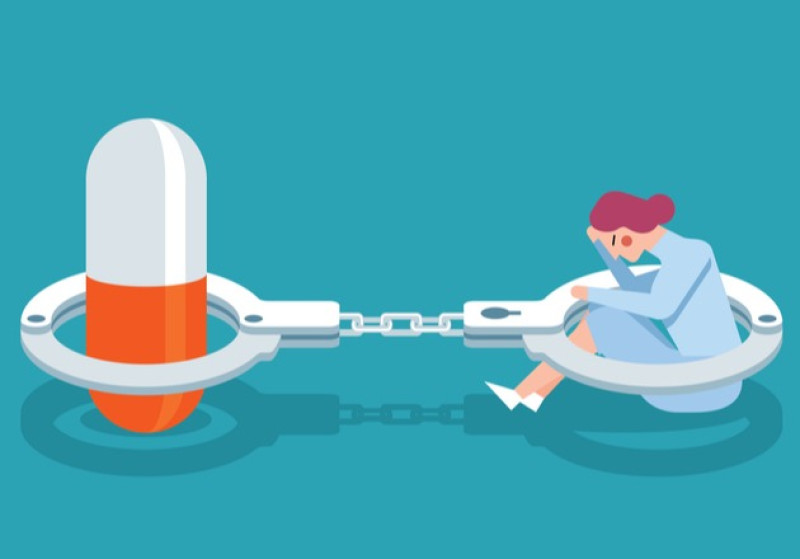
Calls involving drugs and alcohol can be challenging for EMS providers. Not only do many of us have strong opinions or emotions about these substances, but some EMS providers may have personal or family experience with substance abuse, addiction, and withdrawal. In general, withdrawing from a substance is likely to produce the inverse effects that the substance would typically cause (for example, withdrawal from depressants will cause overstimulation and elevated vital signs, and vice versa). We’ll take a closer look at withdrawal from alcohol, opioids, and methamphetamine, as well as considerations for neonatal withdrawal symptoms.
Alcohol Withdrawal
Alcohol is probably the most dangerous substance to withdraw from because it tends to cause seizures. In the brain, alcohol inhibits glutamate (a primary excitatory neurotransmitter) and enhances GABA's (the primary inhibitory neurotransmitter) effects. In patients who consume alcohol every day, physical and chemical changes occur in the brain, such that without the depressive effects of alcohol, they are at risk of seizures. Seizures caused by alcohol withdrawal can be among the most challenging to stop, sometimes requiring multiple medications and intubation. Still, the good news is that they are relatively easy to prevent (and we carry the tools to do so on most ALS ambulances).1
The primary symptoms of alcohol withdrawal are tremors: sometimes, a patient will have “the shakes” in their hands, but a great tool to check for tremors is to have the patient open their mouth and stick their tongue out. If you notice a slight “twitch” in the tongue, that’s a good indicator that the patient is experiencing symptoms of alcohol withdrawal, and you should intervene. Many providers like the tongue test because, anecdotally, it seems tougher for patients to intentionally cover up or try to fake a tremor in their tongue. This is important because patients experiencing withdrawal symptoms may be ashamed of their situation and try to hide a serious medical condition. Alternately, driven by addiction, someone might try to “fake” the symptoms to prompt you to intervene, but frankly, many providers worry a lot less about someone “fooling” the provider out of a dose of medication than they do about not treating someone who needs it.
The primary EMS treatment for alcohol withdrawal symptoms is a benzodiazepine. This may be included in your protocols (for example, the dose might be 2 mg IV midazolam/Versed), but if you don’t have a protocol for treating withdrawal symptoms, call medical control and make your case—here’s a script to get you started: “Hello, this is [your name], I’m a paramedic on [your unit]. I’m calling for orders for midazolam for alcohol withdrawal. My patient is a [age] year-old [sex]; they are experiencing tremors and haven’t consumed alcohol for [number of hours or days]. I’d like to give IV midazolam to control the tremors. Are you okay with a 1 mg starting dose?”
Colloquially, patients might call their tremors “DTs,” confusing the tremors with severe withdrawal symptoms called delirium tremens. Delirium tremens is a condition that involves sensory hallucination, diaphoresis, tachycardia, hypertension, and a fever.1 While seizures are considered moderate alcohol withdrawal symptoms and are most likely to occur 12-24 hours after last ingesting alcohol, delirium tremens (severe symptoms) might last seven days or more.1
Opioid Withdrawal
Chronic opioid users eventually grow excess opioid receptors in their brains and require consistent doses of opioids to prevent withdrawal symptoms.2 Symptoms include irritability, anxiety, restlessness, body aches, GI upset/pain, diaphoresis, yawning, and tachycardia.3 Unlike alcohol withdrawal, there’s no good prehospital treatment for opioid withdrawal. Typically, withdrawal is treated with methadone or buprenorphine, which are both opioid replacements.2 While naloxone (Narcan) administration will reverse an opioid overdose, it will also cause opioid withdrawal. Many patients are prescribed naloxone (in case of overdose) along with their opioids for chronic pain or hospice care. Occasionally, a patient will become curious about the effects of naloxone or think that the naloxone might reverse unpleasant side effects from the opioids they are taking, and “try” a dose of naloxone—this will almost instantly reverse all the effects of their opioid, including the pain management that it was providing, and the symptoms cannot be easily reversed in the field. Symptomatic treatment for opioid withdrawal includes NSAIDs for the body aches and antiemetic medications (like ondansetron) for nausea/vomiting.2
Methamphetamine Withdrawal
As methamphetamine is a stimulant, we can predict its withdrawal symptoms: depressed affect and excessive sleepiness are the hallmarks. While the symptoms of methamphetamine withdrawal aren’t particularly life-threatening, they can last for weeks or months.4,5 Treatment for these patients is best rendered in a capable facility.
Neonatal Drug Withdrawal
When a neonate is born, it no longer receives blood supply from the mother, and for mothers who use drugs during pregnancy, this means that the neonate will begin to withdraw. This is called neonatal abstinence syndrome (NAS). While opioids are the most common illicit drugs used in pregnancy, the use of multiple different illicit drugs is common as well.6 With the rise in opioid use in the United States, the prevalence of NAS has increased from 1.2 to 3.4 cases per thousand live births.6 The presentation is similar to withdrawal symptoms in an adult, though the neonate may express the symptoms differently. For example, a neonate isn’t likely to tell you they are having body aches, but they may exhibit an excessive or inconsolable cry and may have difficulty feeding. Symptoms may present within the first 24 hours for substances like heroin and fentanyl, which have a relatively short half-life or may take several days to appear in substances with longer half-lives.6 Diagnosis relies mainly on accurate history taking, so building rapport with the mother and gathering a complete history of her drug use during pregnancy will be key to managing the neonate’s symptoms. Remember, you cannot change the fact that a mother abused drugs during pregnancy; that ship has already sailed, and now our focus must be on giving the newborn the best care possible. Avoid scornful tone and words, as these will harm rapport and cannot reverse what’s already been done. You’re unlikely to have a protocol for treating NAS, so this is the time to consult an expert. Call medical control and seek their direction regarding treatment options. Morphine is commonly used in the NICU to treat NAS caused by opioids, so you may carry an appropriate drug to provide symptom relief during transport and an eventual bridge to buprenorphine or methadone.6
- 1. Newman, R. K., Stobart Gallagher, M. A., & Gomez, A. E. (2023). Alcohol Withdrawal. In StatPearls. StatPearls Publishing. http://www.ncbi.nlm.nih.gov/books/NBK441882/ http://www.ncbi.nlm.nih.gov/books/NBK441882/
- 2. Shah, M., & Huecker, M. R. (2023). Opioid Withdrawal. In StatPearls. StatPearls Publishing. http://www.ncbi.nlm.nih.gov/books/NBK526012/ http://www.ncbi.nlm.nih.gov/books/NBK526012/
- 3. Tompkins, D. A., Bigelow, G. E., Harrison, J. A., Johnson, R. E., Fudala, P. J., & Strain, E. C. (2009). Concurrent Validation of the Clinical Opiate Withdrawal Scale (COWS) and Single-Item Indices against the Clinical Institute Narcotic Assessment (CINA) Opioid Withdrawal Instrument. Drug and Alcohol Dependence, 105(1–2), 154–159. https://doi.org/10.1016/j.drugalcdep.2009.07.001 https://doi.org/10.1016/j.drugalcdep.2009.07.001
- 4. Gupta, M., Gokarakonda, S. B., & Attia, F. N. (2023). Withdrawal Syndromes. In StatPearls. StatPearls Publishing. http://www.ncbi.nlm.nih.gov/books/NBK459239/ http://www.ncbi.nlm.nih.gov/books/NBK459239/
- 5. Yasaei, R., & Saadabadi, A. (2023). Methamphetamine. In StatPearls. StatPearls Publishing. http://www.ncbi.nlm.nih.gov/books/NBK535356/ http://www.ncbi.nlm.nih.gov/books/NBK535356/
- 6. Shukla, S., Zirkin, L. B., & Gomez Pomar, E. (2023). Perinatal Drug Abuse and Neonatal Drug Withdrawal. In StatPearls. StatPearls Publishing. http://www.ncbi.nlm.nih.gov/books/NBK519061/ http://www.ncbi.nlm.nih.gov/books/NBK519061/
- Dozens of courses and topics
- State-specific requirements
- We report to CAPCE in real time


